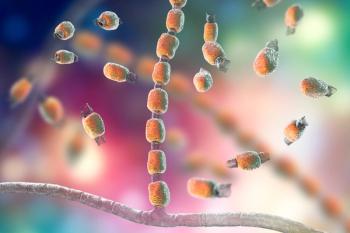
Differentiating the round cell tumors (Proceedings)
Round cell tumors are commonly detected as cutaneous or subcutaneous masses.
Round cell tumors are commonly detected as cutaneous or subcutaneous masses. However, the majority of these tumors also appear in other locations. More differentiated tumors have very unique features that help to identify the specific type of neoplasia. However, poorly differentiated round cell tumors can be very difficult to identify even by histopathology and diagnosis often requires phenotypic marking by immunocytochemistry or flow cytometry.
Mast cell tumor
Mast cell neoplasia are common in both dogs and cats. While the distribution varies somewhat between species (e.g. primary splenic mast cell neoplasia is more common in cats while cutaneous mast cell neoplasia is more common in dogs), mast cell tumors have been reported from nearly every site and organs. Cytologic features include the presence of many individualized mast cells. Well differentiated cells have abundant small blue to purple granules that often obscure the nucleus. Poorly differentiated cells can be highly pleomorphic with multiple criteria of malignancy and few to no granules or large granules. Eosinophilic inflammation often present, but is not always seen. Mesenchymal cells (sometimes with granules) may also be seen. Diff Quik may degranulate the granules of some mast cell and any diagnosis of round cell neoplasia using Diff-Quik that doesn't clearly fall into another category should be further examined by staining new slides (counterstaining previously stained slides will not work) with Wright's or Giemsa based stains.
Lymphoma
Lymphoma may be localized or part of disseminated disease. Cells may be small to large but are uniform in appearance (vs. heterogeneous suggesting lymphoid hyperplasia or inflammation). Nuclei may be round, indented or highly convoluted, the latter being a feature of epitheliotropic lymphomas and Sezary syndrome. However, other malignant T cells and B cells may also have irregular nuclear borders. Chromatin is often fine, even in smaller to intermediate cells. Nucleoli are often seen, but may be indistinct in appearance. The amount and basophilia of the cytoplasm varies with the stage of the neoplastic lymphocytes.
Small lymphocytes are smaller in size than a neutrophil and have a round nuclei that takes up the majority of the cell. The nuclei contain densely aggregated chromatin forming large chromocenters (condensed chromatin). Nucleoli are not seen. The cytoplasm is scant (sometimes only a very thin rim is visible) and lightly basophilic in color. These are typically called 'mature lymphocytes'. However, early lymphoid progenitor cells, hematopoietic stem cells, certain stages and types of dendritic cells, and other immature precursor cells may have a very similar morphology to 'mature, well-differentiated, small, resting lymphocytes'.
Intermediate to large lymphocytes range in size from slightly larger than small lymphocytes to the size of neutrophils. The nuclei still takes up the majority of the cell, however more abundant cytoplasm is visible in these cells. Often, the nuclei is placed eccentrically within the cytoplasm. The nuclear chromatin is finely clumped to granular. Typically, nucleoli are not seen although strands of loosely clumped nuclear chromatin may be mistaken for nucleoli. The cytoplasm is lightly basophilic in color. Occasionally these cells contain azurophilic granules suggestive of a natural killer (NK) phenotype.
Lymphoblasts are as large as a neutrophil or larger. Size alone does not indicate neoplasia. Very large lymphoblasts (2-4x the size of neutrophils) may be seen in reactive and hyperplastic processes. Lymphoblasts contain round to oval nuclei with fine or stippled chromatin (loosely aggregated chromatin). One or more nucleoli may be visible. The cytoplasm is moderately to deeply basophilic. Occasionally (seen more in cats than dogs) the cytoplasm may contain punctate vacuoles.
Plasma cell neoplasia
Plasmacytomas are more common in dogs than cats and the cutaneous forms have a predilection for the oral cavity, ears, digits, and forelimbs. Extraskeletal multiple myeloma and plasmacytoma may be seen in the spleen, liver, and GI tract. In general, plasma cell neoplasias exfoliate well, however the neoplastic cells may appear as 'pockets' within tissues so obtaining several aspirates from a site may increase the likelihood of a diagnosis. Neoplastic plasma cells range from those that appear similar to mature, well-differentiated plasma cells to those that are barely recognizable as plasma cells. Well-differentiated plasma cells have eccentric nuclei, clumped "cartwheel" chromatin, deeply basophilic cytoplasm with discrete margins that is darker at the margins and paler in the perinuclear zone creating a perinuclear clear zone. Binucleated cells are commonly seen and multinucleated cells may be present. Nuclei with less clumped chromatin may be seen. These cells may be more difficult to identify. Poorly differentiated plasma cells need to be differentiated from amelanotic melanoma, osteosarcoma, and malignant histiocytosis.
Histiocytoma
Histiocytoma is a common tumor of young dogs but may also be seen in older dogs. The tumor originates from the Langerhans cell of the epidermis. Most will spontaneously regress following infiltration by CD8+ T-cells, thus the presence of small lymphocytes is often seen. The neoplastic cells exfoliate as individualized round cells with a moderate amount of lightly basophilic cytoplasm. Nuclei are oval or indented with fine chromatin and indistinct nucleoli. The outer edges of the cytoplasm often stains lighter than the perinuclear area.
Histiocytic neoplasia
Cutaneous and systemic histocytosis (histiocytic sarcoma, malignant histiocytosis) are proliferative histiocytic disorders of dogs and cats. Malignant histiocytic neoplasia commonly affects the lung of both dogs and cats. Cutaneous involvement is variably reported in both species. However, any site can be affected. In dogs, histiocytic neoplasia in the dog has been defined as a spectrum of diseases characterized by proliferation of Langerhans dendritic cells, interstitial dendritic cells, or macrophages. The cell of origin in cat is unclear, however a recent report suggests that at least in some cases, malignant histiocytic neoplasia in the cat may originate in the skin. On cytology, malignant histiocytes are large, pleomorphic discrete cells that contain abundant, often vacuolated, deeply basophilic cytoplasm. Nuclei are oval to reniform and contain lacy chromatin and prominent nucleoli. A continuum between discrete histiocytic cells and spindled mesenchymal cells may be seen; the appearance frequently varies in masses from the same animal and may even vary from different sites of the same mass. Variable numbers of multinucleated cells are often seen. Nuclei may be round, indented, or pleomorphic in appearance with fine to lacy chromatin and prominent single to multiple nucleoli. Micronuclei and multinucleation is common. Cells may also exhibit phagocytosis of erythrocytes and leukocytes, which helps to suggest a histiocytic origin, however, phagocytosis is not a consistent feature and phagocytosis can be seen in other malignant cell types. Malignant histiocytic neoplasia can be cytologically (and sometimes histologically!) difficult to differentiate from granulomatous inflammation, anaplastic carcinomas, large cell T-cell lymphoma, pulmonary lymphomatoid granulomatosis, and plasmacytoma or extramedullary myeloma. Positive immunoreactivity to lysozyme or special stains for dendritic origin can aid in this differentiation.
TVT
Transmissible venereal tumor is a transmissible neoplasia of dogs. The cells have only 59 chromosomes compared with normal canine karyotype of 78. The tumors typically occur as soft, pedunculated, friable masses on the mucus membranes of the external genitalia, although other sites and metastasis have been uncommonly reported. Cytologically, these tumors appear as a uniform population of round cells with round nuclei, coarse chromatin and one to two prominent nucleoli and variable amounts of basophilic cytoplasm. A characteristic feature of TVT is the presence of numerous punctate vacuoles in the cytoplasm.
Melanoma
Melanoma can be seen in both dogs and cats. These arise due to a proliferation of melanocytes and therefore are of neural crest origin. However, cells range in morphology from discrete round cells to epithelioid to spindled cells and these cells can be highly variable in both benign and malignant forms. If poorly granulated, these cells are easily mistaken for other tumor types. Pigmentation varies both from tumor to tumor and within tumors. Well differentiated cells have abundant melanin granules which are fine and stain green-black to brown-black and the granules may obscure nuclear and cytoplasmic morphology. Poorly differentiated tumors may have no granules or only a very fine dusting. In these cases, the cytology may appear 'dirty' or that there is some background staining. Even in well differentiated tumors, cells from the deeper margins tend to be less well granulated and thus the cytologic impression may depend on the sampling site. Features of malignancy will vary, however cells from poorly differentiated melanomas are often markedly pleomorphic with variable nuclear to cytoplasmic ratios, anisocytosis and anisokaryosis, finely granular to coarse to lacy chromatin, with prominent nucleoli. Amelanotic melanomas are difficult to differentiate from other round cell neoplasia or mesenchymal neoplasia and sometimes may even have features of epithelial origin (clusters). Melanophages can be mistaken for melanocytes, especially in lymph nodes. Melanophages tend to have coarse aggregates of melanin pigment rather than fine granules.
Newsletter
From exam room tips to practice management insights, get trusted veterinary news delivered straight to your inbox—subscribe to dvm360.




